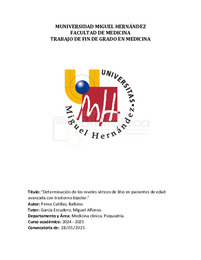Resumen :
Introducción: el trastorno afectivo bipolar en pacientes de edad avanzada (TBEA) presenta un estrecho margen terapéutico con el tratamiento con carbonato de litio, asociando un mayor riesgo de toxicidad en esta población por comorbilidades y cambios asociados a la edad. La evidencia más reciente propone un rango terapéutico reducido con niveles séricos entre 0,4-0,6 mmol/L para pacientes mayores de 50 años.
Objetivos: el objetivo principal de este estudio es evaluar los niveles séricos de litio en personas mayores de 50 años con trastorno afectivo bipolar (TAB) en tratamiento con carbonato de litio en el Hospital General Universitario de Elche.
Material y métodos: se trata de un estudio observacional, descriptivo, retrospectivo y unicéntrico. Se incluyeron pacientes del Departamento de Salud Elche - Hospital General mayores de 50 años con diagnóstico de TAB en tratamiento con carbonato de litio y al menos una determinación de litio en 2023-2024. Se registraron los niveles séricos de litio y variables demográficas, y se realizó el análisis estadístico con el programa R Core Team (2023)®.
Resultados: se incluyeron un total de 199 pacientes, de los cuales el 69,4 % (n=138) presentó litemias fuera del rango 0,4–0,6 mmol/L, el 55,3 % >0,6 mmol/L (n=110) y el 14,1 % <0,4 mmol/L (n=28). Se encontró una correlación negativa entre edad y niveles séricos litio (rho=-0,163; p=0,003), pese a que no hubo diferencias en las litemias dentro y fuera de rango entre subgrupos de edad. La distribución de niveles de litio difirió por sexo (p=0,003); sin diferencias en las medianas (p=0,452).
Conclusión: La mayoría de los pacientes presenta concentraciones de litio en sangre fuera del rango recomendado, especialmente por encima del límite superior. Es necesario individualizar la dosis y frecuencia de control en individuos mayores 50 de años para optimizar la seguridad del tratamiento.
Introduction: bipolar affective disorder in older adults (OABD) presents a narrow therapeutic window when treated with lithium carbonate, with increased toxicity risk due to comorbidities and age-related physiological changes. The most recent evidence proposes a reduced therapeutic range, with serum levels between 0.4–0.6 mmol/L for patients over 50 years.
Objectives: the primary objective of this study is to evaluate serum lithium levels in individuals over 50 years old with bipolar affective disorder (BAD) undergoing treatment with lithium carbonate at the Hospital General Universitario de Elche.
Materials and methods: this is an observational, descriptive, retrospective, single-center study. Patients over 50 years old from the Elche Health Department – General Hospital with a diagnosis of BAD, undergoing lithium carbonate treatment, and with at least one lithium level determination in 2023–2024 were included. Plamatic lithium levels and demographic variables were recorded, and statistical analysis was performed using R Core Team (2023)® software.
Results: a total of 199 patients were included, of whom 69.4% (n=138) had lithium levels outside the 0.4–0.6 mmol/L range; 55.3% (n=110) were >0.6 mmol/L and 14.1% (n=28) were <0.4 mmol/L. A negative correlation was found between age and serum lithium levels (rho = –0.163; p = 0.003), although no significant differences were observed between age subgroups regarding lithium levels inside or outside the proposed range. Lithium level distribution differed by sex (p = 0.003), but median values were not significantly different (p = 0.452).
Conclusion: most patients had serum lithium levels outside the recommended range, predominantly above the upper limit. It is necessary to individualize dosing and monitoring frequency in patients over 50 years old to improve treatment safety.
|
 La licencia se describe como: Atribución-NonComercial-NoDerivada 4.0 Internacional.
La licencia se describe como: Atribución-NonComercial-NoDerivada 4.0 Internacional.
.png)
